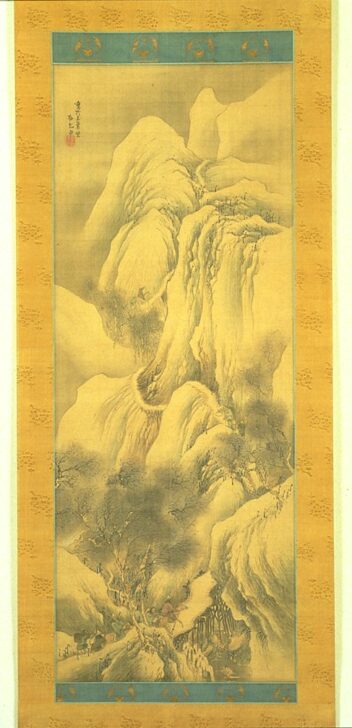The Road to Shu
Matsumura Goshun

Description
This painting is by a Japanese artist working in the Chinese
literati (amateur scholar-artist) tradition. The road to Shu
(present-day Sichuan), famous for its precipitous route
alongside wild river torrents, was the subject of a dramatic
poem by the famous Tang dynasty (618–907) writer Li Bai
(701–762) that was visualized by generations of literati
painters. Characteristically Chinese elements of the painting
include the theme of travelers on a mountain pathway; the
winding S-curve composition; and the overlapping layers
used to depict the mountains. But distinctively Japanese
elements are also present, such as the rounded forms of the
mountains and the use of smudges to depict leaves.
Recently, a painting of the same subject by Goshun’s
teacher Yosa Buson (1716–1784) was discovered in a private
collection in Singapore. The depiction of the travelers is
almost identical in the two paintings. A letter from Buson to
his patron indicates that he wished the patron to purchase
two paintings of this subject, one by Buson and the other
by Goshun. It is possible that UMMA’s painting is the one
referenced in the letter.
Fall 2015 Gallery Rotation
-------------
Many Japanese artists and intellectuals have looked to China for inspiration over time. In this painting, Goshun depicts the rounded mountains of the Japanese landscape in a Chinese-derived composition and brush techniques. Some typically Chinese elements in this work include the theme of travelers on a mountain pathway, the composition which winds upwards in an S-curve, and the depiction of overlapping layers of mountains. Apparently Goshun painted this scene again and again to fufill the requests of his admirers because at least five versions of the Road to Shu by Goshun still exist.¸¸Would the painting be as interesting if it didn't include the figures, small as they are?How does the artist convey the feeling of a cold, desolate landscape?How is the perspective in this painting different from that of Western landscape painting?
Subject Matter:
n this painting, Goshun depicts the rounded mountains of the Japanese landscape in a Chinese-derived composition and brush techniques. Some typically Chinese elements in this work include the theme of travelers on a mountain pathway, the composition which winds upwards in an S-curve, and the depiction of overlapping layers of mountains. Apparently Goshun painted this scene again and again to fufill the requests of his admirers because at least five versions of the Road to Shu by Goshun still exist.
Physical Description:
Travelers are seen on a winding mountain pathway, among overlapping layers of mountains.
"Goshun has powerfully evoked a winter landscape by reserving large areas of blank silk along with scattered touches of white to suggest snow. The heavy overcast sky and the cloudy washes amidst the bare limbs of the trees suggest a gloomy atmosphere appropriate to the theme. The mounted figures and attendants are proceeding along the road towards a mountain pass. Their casual demeanor belies the ordeal through which they have passed."
Adams, Celeste, and Paul Berry. Heart, Mountains, and Human Ways: Japanese Landscape and Figure Painting: a Loan Exhibition from the University of Michigan Museum of Art. Museum of Fine Arts, 1983.
Usage Rights:
If you are interested in using an image for a publication, please visit https://umma.umich.edu/request-image/ for more information and to fill out the online Image Rights and Reproductions Request Form.